The Best Anime Ever Made
It doesn't have epic mech battles.
It doesn't have copious numbers of large breasted girls.
It doesn't span 100+ episodes.
It doesn't have samurai sword battles.
It doesn't have fan service.
It's just a quiet little show, well made, well scored, well acted, and on a creative level so high above anything I could ever manage that I can only watch in awe.
I have, as of this date, watched about 300 complete anime TV series, 220 complete anime OAV series, and 70 anime movies. This show stands above them all. Of all 100 scores I've given, this was the easiest. I've been planning this review since this whole blog thing started a year ago.
Haibane Renmei 10/10

"At the beginning of the world, there was nothing but a dark mist called the Nothingness.
God appeared.
By merely being there he brought light to the Nothingness.
When God took into his hand the halo glowing over his head and held it high, it became the sun.
God waved his staff, and the nothingness was ripped into two, one forming the sky and the other the land.
However, the line was skewed, thus creating mountains and valleys.
"It was a mistake, but it is just as well" said God.
When God drew pictures on the land, grass and trees grew, and birds and animals came to life.
God then envisioned creatures that looked like himself.
But these creatures were too similar to himself and were a failing.
So he coloured their wings charcoal, made holes in their halos, named them Haibane, and tucked them away in the back of his head.
After that God created human beings that did not have wings or halos.
This time, it was a satisfactory creation.
Completely content, God, despite himself, fell asleep.
The Haibane, destined to be erased, were hence able to escape from his head.
When God awoke the Haibane were already floating in the sky.
However, ever tolerant of mistakes, God decided to let the Haibane and their tiny world be.
This is why the town of Glie is still floating somewhere today, where it is neither on land nor sea."
- The Beginning of the World
by Nemu and Rakka
Haibane Renmei runs 13 episodes and aired back in 2002. It's not the most beautiful show but the art is good and the character designs are simple yet effective. There are a couple of crappy scenes in episdoes 3-4 but after that the show maintains a pretty high level of quality for the duration. The score is simple and filled with quiet pieces that lend to the general peaceful nature of the land of the Haibane. The OP is an excellent instrumental with a focus on violin with some piano (the full version has some flute in there and more piano) and I have to say it's my favorite OP in all anime. The ED is a somewhat haunting song called Blue Flow by Heart of Air that's featured in the series proper and is a great contrast to the somewhat optimistic tone of the OP. This show uses it's score and sound effects to great effect. Watch it in complete silence if you can to get the full effect. The VA's in this show are perfect, Rakka, Reki, and the Communicator are particularly good.
Haibane Renmei begins with a young girl, about 14, asleep, falling through a dark sky, a crow flies with her. She awakens, unafraid of her situation though she's aware of it. The crow tries to stop her fall but she tells it, in a timid, kind voice, that it is a wasted effort but thanks the bird for it's efforts. The crow is blown away, the sky brightens to a pale green, and the girl is suddenly falling towards a green land below with fields and trees. She becomes frightened and is blown back up into the air.

Cut to a large old building, inside it is old and worn, and we see a girl, about 17 with long black hair, a golden halo above her head, small charcoal grey wings sprouting from her back...and a cigarette in her mouth. She passes a closed door, opens it, and discovers a 6ft tall white glowing egg attached to the ceiling and floor. After a shocked look she dashes off (returning briefly to put out her dropped cigarette).
We now see that the older girl is not alone, two more arrive at the old building on a bike, and arrive at the egg room with it cordonned off with police tape and the dark haired girl scolding a gaggle of little kids for whom the tape is intended. We must note that all the characters so far have the same halos and wings.

These are the Haibane. Children born from mysterious eggs that appear in the old buildings in which they live, Old Home. Reki is the oldest and the smoker, Nemu about the same age, bespeckled Hikari and tomboyish Kana are a little younger, and Kuu is the youngest of the older girls, a little younger still. The birth of the newest Haibane introduces us to their mysterious birth and nature when the egg cracks open and out spills the girl who was falling through the sky earlier.
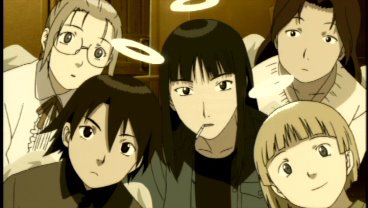
She remembers nothing of where she came from, or who she once was, other than small parts of the dream of falling. She is given the name Rakka, which means "falling", since each of the Haibane are named after what their dream was about. For example, Reki dreamed she was walking a path of small stones so her name means "small stone" from "gareki" (in Japanese). Hikari places a glowing halo above Rakka's head (which they have to tie on with wire until it sticks), and all the girls but Reki rush off to return to their jobs. Reki stays with Rakka through the night while she recovers from the growth of her wings, cleans them of blood, and cares for her during the resulting fever.
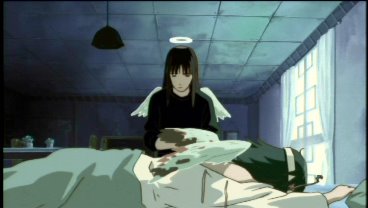
The show now moves into explanation mode since the land in which the Haibane live is rather odd and the girls go to town to show Rakka around. Their world is called Glie and no-one is allowed outside the imposing walls that surround the town and adjacent countryside. The land of Glie has 3 groups of people. The Haibane who live in Old Home and in an old factory at the edge of town, the humans who populate the town, and the Haibane Renmei, a group of silent monks who live in a small temple away from everyone else.
The Haibane work jobs in the town but are only permitted to work for the oldest of any type of business. They are also not paid but are given books by the Haibane Renmei where they enter the work they do then use that to buy things like food but only used goods such as clothes. It is not explained why this is, everyone simply accepts this as how things must be. The people don't involve themselves very much with the Haibane and it's never explained how the people came to be in the town though it's shown that they have kids and grow old and such.

Their world has somewhat advanced technology such as electricity, gasoline, and flashlights and they have books that depict the Earth but the only people allowed in or out of the town are the silent traders known as the Toga. Only the leader of the Haibane Renmei is permitted to communicate with the Toga and then only by a mysterious sign language. It can be assumed that anything not produced in Glie is brought by the Toga from parts unknown. The profits from the trading the Haibane Renmei do supplements the income of the Haibane, particularily for the little children that can't work.

Rakka now goes with Hikari to meet the Haibane Renmei who all look like adults, wear masks and fake wings on their backs. Only the Communicator speaks and the girls are only permitted to speak when the Communicator says it's OK to do so. Rakka is introduced, accepted as a Haibane, gets her book, and they head home.
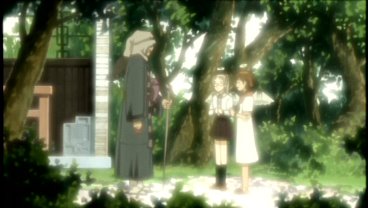
Now she goes to see each of the girls at work to see if there's anything she'd like to do. Reki helps an old woman care for the children at Old Home, Nemu works at the town library, Hikari works at a bakery, Kana works for a watchmaker, and Kuu does odd jobs for the owner of a cafe. One thing to note at this point in the story, as Rakka and Kana bicycle home one evening, Rakka remarks that she thinks she used to sing when she feels as happy as she does and wistfully wishes she could remember a song. It's an unimportant thing but I thought it was a little sad.

During a talk with Nemu we learn that Reki has had a tough time as a Haibane. She once ran away from Old Home after a fight with Nemu and went with a boy from the factory to climb the wall. Even touching the wall is forbidden and the boy was hurt in a fall from his ladder and he and Reki were punished. We also learn that others such as Nemu have had the same questions about their world as Rakka does but the answers are denied them by whatever controls it.
At this point in the story Kuu is acting a little odd. She has a distant look at times and says some odd goodbyes to her boss and others. Then, the next day, Rakka sees a bright beam of light shine from the western woods, and Kuu is gone. The others search for her to be sure but only find some feathers and a now-dark halo at some mysterious stairs in a clearing in the forest. It is her Day of Flight, when a Haibane goes beyond the walls to somewhere unknown, never to return.

Kind-hearted Rakka takes Kuu's departure very hard and heart-brokenly cleans Kuu's room every day for the next month hoping for her return and retreating from the others. During this time her feathers begin to turn black, much to her horror and she starts cutting the dark parts off. Reki catches her and explains that she is sin-bound, as Reki herself is. She gives Rakka a medicine she used on her own black feathers that hides the colour. It turns out that Reki was shunned by all but one Haibane named Kuramori when she was born because of her black feathers and it was the departure of Kuramori that caused Reki to run away and try to scale the wall. Reki assures Rakka that she's done nothing wrong and that it'll clear up in time.
Rakka is still depressed and during a trip to the thrift store with the children she runs off after someone approaches her, happy to have run into a Haibane. She goes into the fields surrounding the town and encounters a crow. Up until now, Rakka has had a feeling that the crows in the town have watching her and she feels an odd affinity for them. She follows the crow into the western woods where they lead her to an old empty well she promptly falls into.
At the bottom of the well she finds the skeleton of a dead crow and has a revelation. She recognizes this crow as the one who had attempted to save her from falling in her dream, and she had been falling because she had been killing herself out lonliness, and the crow was someone she loved very much in her previous life. She buries the crows body in a small grave at the bottom of the well, asks it's forgiveness, and thanks it for it's kindness.
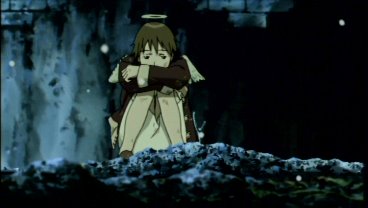
The Haibane Renmei discover Rakka at the bottom of the well, get her out, and on her way home she hears Kuu's voice from the wall and touches it. Then the Communicator appears, and Rakka speaks with him about Kuu, her dream, her experience in the well, and her sin. This is Rakka's catharsis, it's explained in a riddle that one who recognizes their own sin, has no sin. She is left at the edge of the woods where she's found by the others but she must be rushed home becuse she's going numb from having touched the wall.

When caring for her, Reki discovers that Rakka's wings have returned to their proper charcoal grey colour and is dismayed that Rakka has managed to discover the path to redemption that she herself has been searching for for seven long years. Reki begins to lose hope and returns to her mysterious painting room with an air of bitterness.

We now get a flashback of Reki's past. Hatched alone and not found by Kuramori until after her wings had sprouted, feared and avoided by Nemu and the other Haibane because of her black stained wings, and given fearful looks by the townspeople. Her only friend is Kuramori who takes care of her and tries to protect her from the stares of the people. We see her meeting with the Communicator who gives her her name and the medicine for her wings. We see her caught by Kuramori, cutting her feathers, and how she befriends Nemu as they care for the older Haibane when she gets sick finding the herbs for the medicine.

Upon awakening from her reminiscence, Reki rushes off to the Haibane Renmei to demand answers. Why is Rakka being punished? Why is Rakka no longer sin-bound while she herself remains so? The Communicator explains that Rakka had the help of a bird and Reki is surprised to hear that Rakka was given the same riddle Reki herself was given and has yet to solve. Also, the Communicator tells Reki that her time as a Haibane is nearly up and that Nemu hasn't had her Day of Flight either since she's waiting for her friend. Reki returns to Old Home with a lot to think about.

The next day, Rakka is summoned to the temple of the Haibane Renmei to receive punishment for having touched the wall. She is brought by the Communictor into the wall in a special suit and given the task of collecting gold from the walls for the making of halos and cleaning the rusted tags. This is also made her job since she's yet to find one.

Rakka has found her absolution and decides to help her friend find the same. She asks the Communicator for advice and he explains that Reki must face her demons alone. He tells her that Reki has little time left and in not so many words, says she will become one of the silent Haibane Renmei after losing her wings and halo. Rakka goes home and notices that Reki's halo is starting to fade.

Reki prepares herself for the end. She says an unheard goodbye to Nemu, sends a farewell gift to the boy who was hurt climbing the wall for her, and on New Years's Eve, while the others are all sleeping, goes into her painting room for the final time.
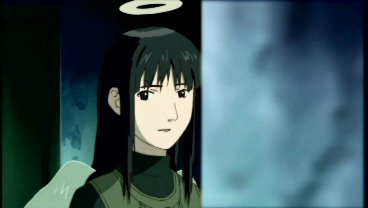
Rakka follows her. The room is revealed to be painted in the image of Reki's dream and that dream quickly becomes understood. A barren landscape under a full moon, Reki walks a path of small stones, with an iron rail on each side. Reki's sin becomes all too clear, and as the train bears down on her once again...well, I can't give away everything.

About a year ago, when I started this blog, I planned for this review to be the 100th and I've been anxiously waiting to post the final picture for this review since it's my favorite scene from my favorite show. I'm not just entertained by this show, but inspired. Sometimes, as I watch TV and movies I get discouraged at the attitudes and behaviour of the characters portrayed. Everyone has an attitude, everyone is selfish, no one gets along for the sake of getting along, people betray each other without a second thought. Anything that tries to be kind and generous feels patronizing and manufactured, fake.
Haibane Renmei is different to me. It's about fundamentally decent people being friendly and kind to one another for no better reason than that's how they are. They have problems and hurt but don't take it out on others. Maybe they're a little unrealistic but I don't care. I'll always love this show.
One final thought.
What are the Haibane? I like to think they are children that die before their time and are given a chance to earn their way into heaven or reincarnation or whatever after atoning for any sins they had. This is why their feathers are charcoal grey rather than white. I also like to think that they'll all meet again somewhere, someday, beyond the wall. Wishful thinking? Perhaps, but the Haibane seem to think they'll meet again and who am I to argue with them?
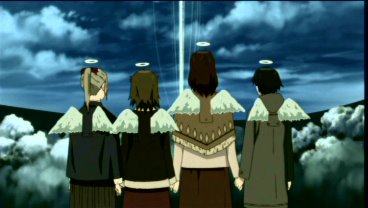

3 Comments:
I've haven't seen it but from your review and the fact it's was created by the same people who created Serial Experiments Lain. I consider it for the next series in my collection.
I certainly think that Haibane Renmei is one of those special shows that really go above and beyond most anything else in it's medium. Best anime ever though, that's a title that I am hesitant to give to any show, let alone this one. While Haibane Renmei is quite excellent, I don't think it is necessarily deserving of that title.
Don't get me wrong, I love the show, and I really wish that it received the attention that a lot of other shows get. I guess it's just a matter of personal preference.
As for a few thoughts of my own, yes, Haibane Renmei is close to a complete package. For the 13 episodes they had, the writers were remarkably able to maintain focus on the themes and characters they wanted. The scenarios are well written, and the flow is executed quite well, although the shift from lightheartedness to a much darker mood is a little jarring. The music is absolutely excellent, I highly recommend the complete soundtrack if you can get it. The artwork is also quite nice, forgoing the bright colours seen in too many other shows, and instead going with a more natural and realistic earth-tone based pallette.
The few flaws that I see with the shows are that there are still many questions left at the end and we don't really get to go too in depth with some of the other Haibane, but considering how the show has length limitations, I am willing to forgive them to a certain degree.
-Js2756
I agree that this is a good show, as for the best I can't give it that. It certainly tries to be different from most anime, in that it doesn't have giant mechs being piloted by women in skimpy outfits, or anything even even close to women in skimpy outfits.. or 4 episode fights that involve about 4 moves.. An interesting idea, interestingly told, but lacking in exposition. Then again, Ground Hogs Day doesn't explain why Bill Murray is reliving the same day over and over, so why should this anime?
9/10
Post a Comment
<< Home